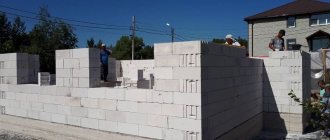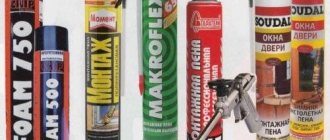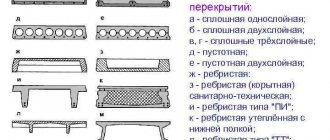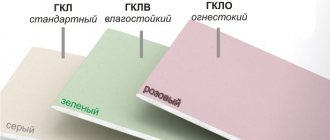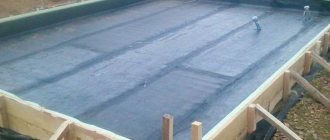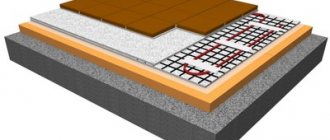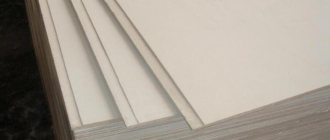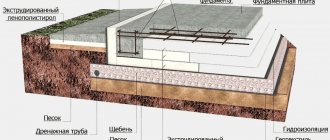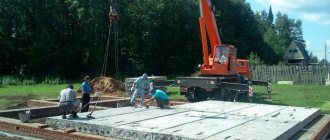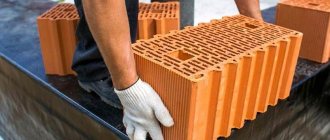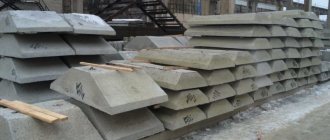How is DSP made?
The cement-bonded particle mixture from which CBPB is made is a kind of concrete based on a mineral binder. Only instead of sand and crushed stone, the filler in it is small wood shavings. The introduction of wood into the composition of the slab reduced its density, but most importantly, the shavings played the role of not only a light filler, but also fiber - an additive that creates volumetric reinforcement that absorbs tensile loads.
The mixture for making the slab includes:
- cement – 65%;
- chips – 24%;
- water – 8.5-9%;
- mineralizing and hydration additives, – 2-2.5%.
Preparation of the mixture begins with chopping the chips to the desired size. After this, it is divided into two fractions on sieves. Small ones are used to form the outer layers of the sheet, larger ones for the middle layer. It is then treated with calcium chloride, “liquid glass”, aluminum chloride or sulfate. This is necessary to protect the material from rotting and fungal attack.
Sifted and treated with mineral additives, shavings are mixed with water and cement. Additives that accelerate the hardening of cement dissolve in water. In addition to the above components, fuel oil and industrial oil I-20 can be added to the mixture in small quantities to reduce internal friction and facilitate pressing.
The prepared mixture is laid out in three layers on pallets, the pallets are stacked and placed in a cold press, where this “package” is compressed to a pressure of 1.8-6.6 MPa and secured in this state with locks. A special locking system maintains pressure in the mold after it is removed from the press.
The compressed bags are heated for 8 hours. During this time, accelerated hydration of cement and its hardening occurs. Wood shavings, due to their elasticity, compensate for cement shrinkage, so the specified dimensions of the slabs do not change. Unlocking molds and relieving pressure also occurs in the press. After this, the package is opened, and the slabs are removed and placed in a buffer warehouse for 1-2 weeks.
For final ripening of the material, it is blown with air at a temperature of 70-100 ° C. After this, the sheets are cut to size, sanded, sorted and transferred to the finished product warehouse.
What is a CBPB board, composition
DSP board is a sheet material for exterior and interior decoration. Can be used on walls, ceilings, roofs, as a subfloor, or as a base for flooring. The composition of CBPB is wood shavings and cement with additives.
This is what a CBPB board looks like. There are shavings visible on the path, although the side surfaces are smooth
- Portland cement grade M500 – 60-65%;
- wood (wooden) shavings of medium and fine fraction – 24-25%;
- water – 8.5-10%;
- additives (calcium chloride, aluminum sulfate, aluminum sulfate, aluminum chloride, sodium silicates) – 2-3%.
Approximate composition of DSP boards
A DSP board is formed from three to four layers. The inner layers in CBPB are made of longer sawdust (sawdust thickness 0.2-0.3 mm, length 10-30 mm), the outer layers are made of smaller ones. The inner layer serves to impart strength and elasticity, while the outer layer makes it possible to make slabs with a smooth surface that requires minimal finishing. The formed sheets are fed into a press, then dried to normal humidity (10-12%).
Types of DSPs and their sizes
According to GOST 26816-2016, cement particle boards of two grades are produced – TsSP-1 and TsSP-2. They are distinguished by dimensional accuracy, strength and other quality parameters.
| Options | TsSP-1 | TsSP-2 |
| Slab size deviations (mm) | 3,0 | 5,0 |
| Deviation in thickness of unpolished slabs (mm) | 0,7-1,5 | 0,8-0,16 |
| Flexural strength (MPa) | 9,0-12,0 | 7,0-9,0 |
| Delamination Strength (MPa) | 0,50 | 0,35 |
| Roughness of ground slabs (µm) | 80 | 100 |
| Stains on the surface | Not allowed | More than 1 piece is not allowed. with a diameter of more than 20 mm per 1 m2. |
| Dents | More than 1 piece, with a depth of more than 1 mm, and a diameter of more than 10 mm per 1 m2, is not allowed. | More than 3 pieces are not allowed. depth more than 2 mm, diameter more than 20 mm per 1 m2. |
The tolerance limits for thickness and bending strength are set separately for different thickness ranges. The slabs are produced in thicknesses from 8 to 40 mm with gradations of 2 mm.
The dimensions of the DSP sheets of both brands are the same:
- Length – 3200 or 3600 mm;
- Width – 1200 or 1250 mm.
In addition to these two brands, there are “related” materials that have similar composition and properties.
Fibrolite
These are slabs filled with wood fibers, so-called wood wool. A filler of this shape provides better fibreing, which has a positive effect on the strength of the material and its resistance to cracking. Fiberboard is relatively soft, has a relatively low density and is often used for thermal insulation and as a sound absorber.
Arbolit
Material related to lightweight concrete. It uses wood shavings, wood chips, chopped reed stalks and rice straw as filler. Arbolite has low strength and is used in structures that do not bear loads, such as internal partitions.
Xylolite
This material is made using magnesium binder - Sorel cement. Insensitive to water. It is used for covering floors, roofs and other structures where frequent moistening of the slabs is possible.
Advantages and disadvantages
Like any building material, DSP has a number of advantages and disadvantages. The advantages of such plates include:
- The material is very resistant to moisture and temperature changes. The slabs can withstand up to 50 frost cycles. This characteristic significantly affects the service life of the slabs.
- The raw materials used to create such partitions are absolutely safe for human health. DSP does not release harmful toxins and does not cause allergic reactions.
- Cement bonded particle board is perfect for various transformations. With it you can use any finishing methods and change the surface of the product at your own request.
- A wide range of. In modern construction stores you can find a wide variety of products.
- The affordable price is an important advantage. Since the material is often used when building a home from scratch, purchasing large quantities of material will not negatively impact your budget.
- Plates of this type are very durable.
- An important feature when using DSP as interior partitions is their good sound absorption. They create the necessary level of sound insulation and additional comfort in the room.
- Unlike some other materials, DSP is not exposed to parasites, harmful insects or rodents that may periodically appear in a private home.
- The material is not subject to instant fire. The stove can only ignite when exposed to an open flame.
- DSPs are very durable. Such slabs can last for decades.
- Cement-bonded products are easy to use. On such a surface it is convenient to carry out various repair work using a drill, hammer drill or knife.
- The fixed size of the products significantly simplifies the installation process.
- The material is resistant to rotting processes.
- When a cement-bonded particle board is used to screed floors, it contributes to significant cost savings compared, for example, with self-leveling compounds or a cement-sand leveling option.
The negative properties of DSP include:
- Products can reach a large mass, which significantly complicates their use in high rooms. The high weight is due to the high density of the material.
- The material is not plastic. If you try to bend such a slab, you can break it. The risk of breakdown during construction work explains the need to purchase material in reserve.
Based on the presented data, it is clear that DSP has significantly more advantages than disadvantages. The disadvantages of such products are easily compensated by their advantages.
Characteristics and properties
Cement particle boards appeared relatively recently, but are becoming increasingly popular, and all thanks to their excellent performance properties:
- Density of CBPB is 1100-1400 kg/m³. High density gives frame structures an increased level of rigidity. If this material is used for interior finishing work, such walls have sufficient load-bearing capacity to support shelves, cabinets and other fairly heavy objects.
Specific resistance to pulling out self-tapping screws from a CBPB board
- Normal humidity is 9% (±3%).
- Low water absorption (about 16% after 24-hour immersion in water) allows this type of material to be used for exterior finishing and for wall cladding in rooms with high humidity. When in water for 24 hours, the limit for thickness increase is no more than 1.5%. That is, when wet they hardly change size.
- Strength indicators: modulus of elasticity in compression and bending 2500 MPa;
- in tension - 3000 MPa;
- in shear - 1200 MPa.
Comparison of DSP and OSB in terms of flammability
- reduction in the level of air noise for a 10 mm thick CBPB board is about 30 dB, for 12 mm - 31 dB;
In addition, the DSP board has high resistance to rotting. This happens due to the natural process of formation of calcium hydroxide, which is formed during the transformation of cement into concrete and alkalizes the material so that it becomes an unfavorable environment for the habitat of fungi, insects and putrefactive bacteria.
Cement particle board - raw material base, manufacturing method, technical characteristics
One of the main advantages of these boards is their natural composition - they do not contain formaldehyde or other aggressive chemicals that are released into the environment during operation. Products from different industries may differ in the composition of mineral additives, but the quantitative proportion of each group of substances used remains unchanged:
- Binder (Portland cement m500, GOST 10178-85) – 65%;
- Wood shavings – 24%;
- Water – 8.5%;
- Hydration (mineralizing) additives – 2.5%.
DSP is a composite material made from a mixture of cement and smooth, thin chips of softwood. Since wood contains sugars and other substances that negatively affect cement and make it difficult to form a monolithic structure, mineralizing additives are used to neutralize them. This can be calcium chloride, aluminum sulfate, aluminum sulfate, aluminum chloride, sodium silicates and others. The shavings are treated with reagents, mixed with cement until a homogeneous mass is formed, and then sent for molding. To increase strength and obtain a smooth and uniform surface, slabs are formed from several layers, which differ in both the size of the chips and their location. Most often there are three layers - the middle one, made of coarser and larger chips, the outer ones - from smaller ones. Some industries form a particle-cement carpet of four layers, but the principle is the same - large fractions inside. The formed slabs are pressed under a pressure of 1.8-2.0 MPa, after which they are subjected to heat treatment in a hardening chamber (8 hours at 50-80⁰C, humidity 50-60%). The parameters of the finished slabs must comply with GOST 26816-86, there is also a European standard - EN 634-2.
The stoves have a lot of physical and technical characteristics that will tell little to the average consumer, who is mostly interested in whether a DSP stove burns, so let’s look at the main ones:
- Thickness – 8-40 mm;
- Density – 1100-1400 kg/mᶟ;
- Bending strength – 45-65 MPa;
- Frost resistance – 50 cycles;
- Thermal conductivity – 0.26 W/(m*C);
- Biostability – damage by microorganisms is excluded, since the production process creates an alkaline environment that is harmful to mold, fungi and parasites. Well, mice and insects gnawing cement, even with the inclusion of shavings, is also a dubious pleasure;
- Flammability group - G-1 (hard-to-burn material that does not emit toxins during combustion and does not spread flame);
- The warranty period for use in building structures is 50 years.
According to the regulations, slabs can be either 1250 mm or 1200 mm wide. The first option is outdated, although many enterprises, especially the “mastodons” of the industry, still produce slabs of this width. Length: two main sizes are common - either 2700 mm or 3200, but there are also 3000 mm options, and the required parameters can be made to order. Despite a lot of advantages, the slabs have a significant drawback - due to the raw material base, they turn out to be quite heavy. The thinnest slab, 8x1250x3200 mm, will weigh about 36 kg, and a 40 mm thick slab with the same dimensions will already weigh 185 kg. Therefore, when working with slabs, an assistant is usually required, equipment is required to unload large quantities, and the limitation for use on the facade is a height of more than three floors. But this material is used in almost all construction fields, depending on the thickness:
- Internal wall cladding – 8-12 mm;
- Interior partitions – 8-20 mm;
- Roofing systems, facade cladding – 10-16 mm;
- Subfloor (ceilings, floating screed) – 16-26 mm;
- Formwork – 14-26 mm;
- Enclosing structures during the construction of frame houses - 10-40 mm.
Density and weight
The average density of this material is about 750 kilograms per cubic meter. Extreme indicators range respectively from 1100 kilograms to 400 kilograms per cubic meter. This density is much lower than that of most building materials made using cement. The weight of the slabs is about 42-54 kilograms with a thickness of 10 millimeters and dimensions of 3.2 by 1.2 meters.
Biological stability and moisture resistance
Treatment with special compositions of wood filler allows the boards to perfectly resist biological effects in the form of mold and rot. Moisture resistance is ensured by the use of Portland cement in the material. Despite prolonged immersion in water, the material absorbs no more than 16% of moisture from its mass, and swelling does not exceed 1.5%.
Resistance to sub-zero temperatures
Since the boards have low absorbency, this allows them to successfully resist sudden temperature changes. Resistance to frost is about 50 cycles of freezing and thawing. This makes it possible to use the material on objects without heating, provided that moisture accumulation in the slabs is prevented.
DSP on the facade of a frame-panel house
Thermal conductivity
Since in CBPB a larger volume is occupied by wood chips, the slab, by definition, turns out to be porous. Thanks to this structure, the thermal conductivity of the slabs is two orders of magnitude higher than that of brick, and almost two orders of magnitude higher than that of plasterboard. DSP does not fully qualify as insulating materials, but their use seriously affects the final insulation of the room.
Vapor permeability
The vapor permeability of these slabs is almost the same as concrete. When designing multilayer walls, this indicator must be taken into account. The slab can successfully serve as a vapor-limiting loop in buildings, protecting them from dampness and improving insulation.
High temperature resistance
The sum of fireproof parameters makes the material practically non-flammable and safe. When using slabs on objects, their fire hazard class is reduced. The fire resistance of structures is significantly increased.
Ecological cleanliness
Modern production of building materials widely uses synthetic raw materials; at the same time, more and more attention is being paid to the environment. Compromises have to be sought to solve this difficult problem, but DSP has no environmental disadvantages. In its production, only natural ingredients are used.
Finishing DSP indoors
On the contrary, substances from its composition, for example, formaldehyde from tree resin, compensate for the effects of toxic compounds. Mineral additives introduced into the board protect it from rotting and mold; for this reason, DSP is an environmentally friendly material.
Treatment
In this regard, DSPs show excellent characteristics. They can be drilled and cut - and these operations are done without much effort. The board has good adhesion properties, and treatment with putty or various paints and varnishes is not difficult.
Sheet weight
In the table above, the data is shown in a separate column. The weight of the sheet directly depends on two fundamental factors: thickness and area of the product. At the same time, the length and width of the sheet are usually standard; only the thickness changes, which largely determines the performance characteristics and scope of application. Let's look at the change in the weight of a standard sheet (3,200 * 1,250 mm) depending on the thickness. It looks like this:
- Thickness 10 mm – weight 54 kg.
- 12 mm – 64.8 kg.
- 16 mm – 80 kg.
- 20 mm – 108 kg.
The weight of the densest sheets can reach up to 194 kg , however, such material is very inconvenient for independent work. For cladding walls and arranging interior partitions, sheets with a thickness of 16-20 mm .
Production Features
There are several technological stages:
- A mixture of water and binding additives is prepared in a special container.
- Crushed wood shavings are added to the liquid ingredients. Mineralization occurs.
- Cement is added to the mixture.
- The solution is distributed into molds, and a certain thickness is set using presses.
- They are thermally treated and the condition of the material is recorded in chambers.
- The CSM is dried, polished, and cut in accordance with established standards.
Features of installation and finishing
Cement-bonded bonding materials are intended for dry installation. In construction and finishing works, they perform the same functions as chipboard, plywood, plasterboard, slate, and concrete plaster.
Some use cases:
- construction of permanent formwork during the construction of buildings, including multi-storey buildings;
- finishing, restoration of facades, foundations;
- basis for fencing, protective structures;
- arrangement of garden paths;
- creation of ceiling coverings, interior partitions, bases for roofs, floors;
- insulation, lining of fireplaces, stoves, chimneys.
Cement particle boards are used in many types of construction and repair work . They cut perfectly, do not crumble when drilling holes for fasteners, and hold plaster and primer mixtures, paint, ceramic tiles, and wallpaper. This is an excellent base for creating various designs and interiors.
When using DSP, the main attention must be paid to storage and transportation . The material contains cement and mineral additives, so it is quite fragile and can be damaged as a result of improper loads. Before use, sheets must be in a horizontal position and supported. When transporting, the material must be placed on its edge.
During installation, the sheets are fixed to the surface at least at three points . For vertical installation, use material with a thickness of about 15–20 mm. Holes for fasteners are drilled in advance. When moving slabs from place to place, precautions must be taken. When sawing, tools with working surfaces of increased hardness are used.
Putty is not used to seal joining joints . Cement particle board mainly consists of natural components, so during operation it can expand and contract. Visually, these changes are invisible, but rigid fixation can cause disruption of the integrity of the seams and the appearance of cracks in them. Typically, the gaps between the sheets are masked with silicone sealants and sewn up with narrow wooden slats or a metal profile.
The surface formed by cement particle boards is strong, stable, and does not require additional leveling or complex finishing. There is no need to soak in antiseptics or smooth out defects. The material can be coated on top with a primer to increase adhesion. Then paint or paste over it. DSP is an excellent basis for carpet, linoleum, laminate, mosaic tiles, and other finishing materials.
Scope of application of CBPB boards
As mentioned above, DSP boards, the use of which ensures high mechanical strength of the structures being created, are widely used in construction, repair and finishing work, in particular:
- In the manufacture of formwork
for foundations and other monolithic reinforced structures. The use of DSP significantly simplifies the installation process; in addition, this design prevents concrete leakage and ensures the formation of smooth side walls that do not require subsequent plastering. - When covering walls and erecting internal partitions
. In most cases, DSP sheets are attached to a pre-assembled metal or wooden frame. The thickness of the sheets in this case ranges from 8 to 12 mm. For fastening, self-tapping screws are most often used; it is also possible to use screws or nails as fasteners. In some cases, when leveling walls, special adhesive polymer mixtures can be used. - The use of DSP boards for flooring
provides high mechanical strength, as well as high rates of heat, water and sound insulation. The thickness of the material is selected based on the current loads and the distance between the lags, however, the use of CBPB boards with a thickness of less than 14 mm is not recommended. - Application to the facade
of a house allows not only to significantly reduce the time required for exterior finishing work, but also provides high-quality waterproofing of the main walls. Another advantage is that when using DSP, the characteristics of the material allow you to create various types of ventilated facades. As for the sheet thickness, for outdoor use it can vary from 12 to 14 mm.
Application area
DSPs are mainly used in dry installation technologies. They are good for the construction of frame houses, since they do not emit harmful substances, have high strength, are low flammable, emit a small amount of smoke during a fire, and do not spread fire. Having high mechanical strength, they increase the rigidity of frame structures. All this makes frame houses sheathed with DSP safer and more reliable.
Cement particle boards are used for construction, finishing
Objects for using DSP
DSP sheets can be used in the construction of the following objects:
- Frame residential buildings up to 3 floors inclusive.
- Industrial, office buildings.
- Hotel complexes.
- Kindergartens, schools.
- Medical institutions.
- Sport halls.
- Warehouses, hangars.
Disadvantage: the DSP board has a significant mass (several times heavier than OSB), which increases the requirements for the foundation. The heavy weight also becomes a problem when climbing to the second floor - you need helpers and scaffolding or lifting equipment (at least a winch). Another disadvantage of DSP is its low resistance to bending loads. This limits their scope of application - they are placed on the base, in places with low bending load, or must be mounted vertically.
Frame houses are built using DSP
Resistance to weathering and high humidity, fungi and bacterial infections allows the use of cement-bonded particle boards in the construction of outbuildings: sheds, outdoor toilets, cellar garages.
For finishing external and internal works
Another area of application for cement particle boards is leveling floors and walls. Compared to other materials, the DSP board has better sound insulation characteristics, is not susceptible to fungi, and tolerates climatic influences well. Therefore, they are often used to create ventilated facades.
Examples of using DSP in the construction and finishing of private houses
For interior finishing, DSP boards can be used for the following work:
- Soundproof and fire-resistant partitions and walls.
- Internal cladding of premises for any purpose (residential and non-residential, including those with high humidity).
- Window sills.
- Rough floor.
- Ceilings.
The positive point is that there are cement bonded particle boards, sanded and unsanded. Polished ones have an absolutely smooth surface. When using them, you can only seal the seams and then paint, glue wallpaper, or use other finishing methods.
DSP properties application
Cement particle board in construction
Over the past decades, dry installation technologies have increasingly been used in residential and civil construction. They can significantly improve consumables and raise the level of quality of work performed. In practice, inexpensive and safe cement particle boards are often used. Studying the technical and operational characteristics, areas of application, as well as consumer reviews and a review of current prices will help you understand the benefits of working with this material.
The building element is a monolithic slab containing the following substances:
- cement – up to 65%;
- coniferous tree shavings – about 25%;
- water – 8.5%;
- additives – 2.5%.
The prepared components are mixed and placed under a press. The formed sheets are heated to 90°C for 7-8 hours, then cooled under natural conditions. Final hardening occurs after about two weeks.
Special additives (antiseptics, plasticizers, hydration admixtures) help improve the quality characteristics of CBPB and enrich them with new properties.
The use of natural raw materials in the production makes the panels absolutely safe for humans. Houses built from slabs are strong with smooth internal and external surfaces. The walls allow air to pass through well, which contributes to the formation of an optimal micro-regime in the premises.
The slabs can be easily subjected to various types of processing:
- cut to achieve the desired size;
- drill holes;
- milling to obtain parts of arbitrary shapes;
- grind the ends to ensure joint strength.
Many finishing options are applicable on the surface of DSP panels:
- painting work with the application of primers and paints made of silicone and acrylic;
- pasting with vinyl trellises or glass wallpaper;
- facing with ceramic tiles.
Externally, the panels are very similar to chipboard (chipboard). These materials should not be confused, since CBPB contains more cement, which means it is much stronger. In addition, it has versatility of use.
Technical characteristics of DSP
The thickness of the plates is in the range of 8-36 mm. Geometric dimensions are determined by regulatory documents and are: width 1200/1250 mm, length 2600/2700/3200 mm. Upon pre-order, the company can produce any size of slab. for example, with a length of 3000 or 3600 mm.
At a relative air humidity of 6-12%, the figure is 1300 kg/cm2. The maximum swelling of DSP sheets is up to 2%. The maximum water absorption standard is no more than 16%.
The relief of the panels depends on the degree of surface treatment with grinding equipment. According to GOST, the roughness of untreated CBPB elements does not exceed 320 microns, and polished ones – up to 80 microns.
In practice, there is a cement-bonded particle board with a thickness of about 4 mm. It does not require additional surface treatment, which has a positive effect on the final cost of the products.
Where are DSP panels used?
Material made from cement and wood chips is a high-strength construction base with good environmental friendliness and sustainability. It is widely used in the construction and reconstruction of civil, industrial and agricultural facilities.
DSP sheets form an excellent basis for modular construction. With their help, heat-saving and sound-absorbing walls are created in frame houses. The slabs perfectly level the base of the floor and make it warm, which significantly increases its service life. Dimensional accuracy facilitates faster installation of panels into the frame.
It is advisable to use such slabs in the construction of permanent formwork, fencing, and facade finishing. This greatly reduces work time, provides structures with the necessary reliability and saves overall construction costs.
Excellent performance characteristics make it possible to use slabs for floors, walls and ceilings in wet rooms, for example, a bathroom or bathhouse.
Advantages and disadvantages of DSP panels
A truly working legal way to save money. Everyone needs to know this!
The main advantages of using the material:
- high strength;
- absence of toxic and carcinogenic components;
- thermal protection;
- moisture resistance;
- resistance to biological aggression, insects and rodents;
- good sound insulation;
- operation in various climatic conditions;
- acceptable cost.
Feedback from experts confirms the small number of shortcomings of DSP panels.
- Large mass complicates the transportation and installation of elements, which somewhat slows down the work process.
- Brittleness when bending - a smooth base is required for laying slabs. It is advisable to buy building material with a reserve of 10-15% more than planned by the estimate.
- Limited service life - only valid under severe operating conditions.
Negative aspects lead to a slight increase in the cost of construction work.
Recommendations before use
When purchasing consumables, you should take into account the various characteristics of the stove.
The choice of sheets of the optimal size depends on the installation location. It should be remembered that an increase in product parameters leads to an increase in the total load on the structure. Therefore, for flooring it is better to buy sheets with a thickness of 8-20 mm, for façade cladding choose 12-16 mm, and for canopies, window sills, and countertops, 20-36 mm is suitable.
The type of front surface is important when finishing interior walls and facades. Manufacturers offer a wide range of panels with smooth and corrugated coatings that imitate marble, quartz, and sand.
When choosing a brand, it is recommended to give preference to well-known manufacturers with a good reputation.
“I have been professionally engaged in construction work of varying complexity for many years. I noted many advantages of using slabs. In particular, a minimum of time is spent on finishing the facade. Thick panels are easy to cut with a circular saw with a wood disc, thin panels with a regular hacksaw. It is also convenient to mount it on the frame by making holes with a regular drill. No tension is required, the panels are durable, can be laid quickly, forming smooth surfaces.”
Andrey, Yaroslavl region.
“I gained my first experience using DSP while tiling a garage. It turned out that the slabs were not at all difficult to cut and attach. I painted the finished walls with acrylic paint, it turned out well. Now it’s time to install the floor in the kitchen. There is one significant drawback: it is profitable to buy the material only in large quantities. The retail price of the sheet is much more expensive. So for small volumes of work, DSP is not worth using.”
“According to the designers’ plans, marble window sills were planned for the country house. The price turned out to be too high, so they decided to replace the natural stone with an imitation of cement bonded particle board. It turned out to be a great pleasure to work with such material - it can be easily sawed with a hacksaw and sanded with a plane. I was pleased with the result, and my friends are still confident that we have real marble.”
Victor Tretyakov, Leningrad region.
“Based on reviews from the Internet and the advice of friends, I decided to try DSP panels for flooring. First, a thick slab was laid on a layer of crushed stone. Then insulation, waterproofing and joists with cross members. Thin 16 mm slabs were used on the subfloor, and linoleum was laid on top. It turned out inexpensive, smooth and warm. The floor does not allow moisture to pass through and breathes well.”
Nikolay, Stavropol region.
“I wanted to build a fence at the dacha from corrugated sheet metal. I calculated the expenses in advance and it turned out to be a large sum. I started studying the characteristics of other materials and came across DSP. The material turned out to be much stronger and cheaper. I installed the supports myself, welded metal profiles to them and secured the sheets with self-tapping screws. The result is a durable and beautiful fence. Manufacturers assured that the material is very strong and does not rot. I’ve had it for five years now and have no complaints.”
Price table for DSP of various sizes
Cement particle boards: characteristics and scope of application
Not long ago, the country (in the USSR since 1987) launched the production of CBPB. How are cement particle boards used in modern construction and what do they represent?
Brief characteristics of cement bonded particle boards
CSP is a sheet composite material, for the manufacture of which medium and thin wood shavings (24%), Portland cement M500 (65%), special chemical additives (2.5%) are used to reduce the negative impact of wood extracts on cement, and water (8 .5%) (Image 1). The slabs are produced by pressing at a temperature of 900°C for 8 hours. After this, the products are kept under natural conditions for 2 weeks.
The most famous domestic manufacturer is the Tamak plant in Tambov. Plates are also produced by TsSP-Svir (St. Petersburg), the Kostroma TsSP plant, the Omsk Stropan, the Tyumen Sibzhilstroy and the Building Structures Plant located in Sterlitamak.
Russian products meet the requirements of GOST 26816-86. It is divided into 2 brands: TsSP-1, TsSP-2. The latter grade of sheets is subject to less stringent requirements than TsSP-1.
Cement particle boards have:
- density 1100-1400 kg/m³;
- high specific thermal conductivity - 1.15 kJ/kg*0°C;
- vapor permeability of 0.03 mg/m*h*Pa (“breathable” material);
- fire resistance - practically does not burn, does not emit toxic gases and vapors at high temperatures;
- water resistance;
- resistance to rotting;
- high sound insulation;
- durability: 50 years warranty for use in building structures;
- high strength to longitudinal deformation;
- surface evenness.
But cement particle boards, whose technical characteristics are generally good, also have a number of disadvantages:
- high price;
- during processing, an incredible amount of dust is generated, as a result of which the use of dust extractors, safety glasses and respirators is simply necessary;
- heavy material: 1 m² weighs approximately 10 kg, which makes it difficult to lift it to the upper floors of buildings, and for structures using DSP, you need a reliable, strong frame made of wooden beams with a cross-section of at least 50x50 mm or rectangular pipes, the cross-section of which is 50x20 mm;
- low bending strength;
- insufficient ease of processing: at a construction site they are cut with grinders and hand-held circular saws (Image 2.3) using cutting tools with carbide plates or diamond wheels; the sheets can be drilled, but it is better to perform these operations in the factory.
Application areas of DSP
The versatility of the boards allows them to be used to solve various construction problems.
First of all, these are external works: construction of frame buildings, finishing of facades of residential buildings, warehouses and agricultural premises, use as a basis for soft roofing, fencing of balconies and loggias, use as permanent formwork for foundations.
Facade cladding (Image 4) is carried out by attaching cement-bonded sheets using nails, self-tapping screws, metal brackets or screws to a frame made of wooden beams or a metal profile. The optimal lathing pitch is 60 cm; it is preferable to mount the beams vertically; for small areas, horizontal installation can be used. Gaps of 4-5 mm are left between the sheets, which prevent their deformation when the air temperature changes. The gaps are filled with elastic mastic or a sealing gasket, which is covered from the outside with purchased or made from chipboard scraps. Depending on the purpose of the building, the space between the wall and the slabs can be left empty, or it can be filled with modern insulation; this is very important for residential buildings. After fastening, the sheets are primed and decorative plaster is applied or simply painted.
When making a base for a soft roof, special attention should be paid to waterproofing the joints. Technologically, the process of manufacturing a base from DSP is similar to working with wood materials.
For fencing balconies and loggias, using cement particle boards is much more expedient than using asbestos-cement sheets, because instead of fragile material, a strong and durable fence is constructed.
DSP formwork (Image 5) is increasingly used in the construction of low-rise buildings. It provides:
- Reduced labor costs and work completion time due to the simplest installation of the structure; moreover, it does not need to be dismantled.
- Painting the outside of the DSP sheets with special paints ensures vertical waterproofing of the foundation.
- The design provides additional strength to the manufactured foundation.
- The formwork retains its shape when concrete is poured and hardened.
- make a base for the floor;
- form underlying or leveling layers;
- lay a warm and clean floor with a top covering;
- lay the floor directly on the ground.
Application of DSP for interior work
Due to the complete absence of the release of any harmful gases and vapors during operation, cement particle boards are recommended for interior decoration (Image 6): they are used to level the walls (either attached to a frame made of the most rigid reinforced profile, or to a special mortar or mastic) , form internal partitions, especially in conditions of high humidity (to increase service life, such a partition should be treated with a water-repellent agent and painted with water-resistant paint).
Floor installation using DSP
DSP boards are also used for flooring (Image 7), and their use is preferable to the use of chipboard (chipboard) or oriented strand board (OSB). Typically, the laying of DSP for flooring is carried out on logs having a cross-section of 50x80 mm, in increments of 600 mm.
With the help of DSP you can:
The thickness of the DSP is:
Cement particle boards can be safely recommended for performing the above work. But it is necessary to use products from a domestic manufacturer, and not to purchase Chinese chipboards. Using the products of hardworking Asians can lead to swelling of the slabs, their chipping, the sheets themselves may be crooked and the surface uneven.
What is OSB board like: its characteristics and application
Features of larch floor boards Step-by-step installation of parquet How to make a concrete floor in a private house
DSP board: application for flooring, properties and reviews
Today, the DSP board has gained popularity: the use of this material for flooring is very convenient. This is due to several reasons, the first of which is absolute environmental friendliness, the second is low cost. The board is based exclusively on natural raw materials. The binding components are mineral substances that do not release poisons and microelements during operation that would be dangerous to human health. Among the ingredients of the canvas are wood shavings, water, Portland cement, as well as special additives. During the production process, the listed components are combined and undergo a pressing stage.
Application of DSP for flooring
Today, it is quite common to finish the floor area with DSP boards. This material is characterized by excellent thermal insulation properties, in addition, it can be used in conditions characterized by high humidity. After installation, the slabs will need to be protected with a primer or water-repellent mixture. The canvas will last for a long time, as it can withstand heavy loads. Depending on the traffic flow in the room, you can choose slabs with more or less impressive thickness.
Despite the fact that the DSP board has excellent performance characteristics, its use for flooring must be accompanied by compliance with all installation rules; only then will it be possible to preserve all the qualities of the material. With the help of such a slab, you can perfectly level the floor surface in a short time. The use of this material allows us to reduce the period of work. The floor will be strong and reliable, and construction costs will be significantly reduced.
Characteristics of DSP
The material contains 24% wood chips, 8.5% liquid, and 65% cement, which ensures the durability and strength of the slab. In addition, among the ingredients there are 2.5% hydration impurities such as liquid glass and aluminum sulfate. Depending on the floor parameters, you can choose slabs that have dimensions of 3200 x 1250 mm, while the thickness can vary between 10-40 mm. But, according to the standards, the slab can be manufactured with other parameters; deviations depend on the thickness.
Density and surface features
When considering the properties of a CBPB board, it is worth paying attention to the density, which should not exceed 1300 kg/m2, while the humidity can vary between 6-12%. When exposed to water for 24 hours, the canvas should not swell by more than 2%, and the slab can absorb moisture in a volume of approximately 16%. Tensile strength is 0.4 MPa.
The surface of the material should be rough, and the degree of roughness will be affected by grinding. If manufacturing is carried out in accordance with GOST 7016-82, then the roughness of the plates will be more than 320 microns, but the blade may not be subjected to grinding, then this figure is within 80 microns.
Types of DSP
DSP board, the use of which today, as already mentioned, is becoming increasingly popular, is produced on modern equipment in several varieties. These are, for example, slabs whose thickness is only 4 mm. The resulting material does not require grinding, which, when done, causes an increase in cost. Slabs that have smooth embossing are becoming increasingly popular. They contain small elements, the size of which increases closer to the center of the canvas. Using this material you can get a floor that will look like natural stone. That is why the canvas does not require additional finishing after installation.
Advantages of DSP over other materials
If you have not yet decided what kind of floor covering will be laid: fiberboard or DSP board, the use of these materials for the floor, or rather, their qualitative advantages, is worth considering in more detail. Despite the fact that there are a great variety of slabs for repair work on the market of modern building materials, CBPB can be considered the leader. So, if we compare a sheet of DSP with a fiberboard sheet, then the first one is much stronger. In addition, cement particle board has the quality of frost resistance, which makes it possible to use this material as a floor covering in houses that are not used for the whole year, but only during the warm period.
DSP board, the use of which is very popular for flooring, is also distinguished by its resistance to fire, as well as impressive temperature variations. In addition, it is not afraid of parasites, including fungi, mold, mice and insects. After laying the DSP, the surface can be finished at your discretion - this could be painting, laying tiles, applying plaster, etc. If you do not know how to finish the floor surface after installation, then you can think about how to do this in the case of traditional wood . A floor coated with DSP will acquire the qualities of a sound insulator with an index of up to 30 dB.
If you need a fairly durable surface, then you should choose a cement-bonded particle board: a cement-bonded particle board has just such qualities, they are due to the fact that the canvas is based on three layers, two of which (the outer ones) are made of fine chips, while the inner one consists of longer particles. This gives the material elasticity, high density and hardness. You should not be afraid that the slab will delaminate during use.
Preparatory work
The DSP board, the use of which is discussed in this article, involves the use of self-tapping screws when working with it. You can purchase canvases with a thickness in the range of 1-1.5 cm. It is permissible to use wood or concrete screed as a rough coating. If there are logs on the floor, then the DSP can be installed on top of them. It is recommended to cut the material with a fine-toothed hacksaw blade. This will reduce the amount of dust generated, and the edges will be as neat as possible. Initially, the sheet just needs to be cut, laid on a flat surface, with the groove facing down. Next, you need to place your knee on the larger part of the canvas, and pull the smaller part towards you. In the required place, the slab should crack along the cut.
If during the repair work it is necessary to bypass the pipeline system, then grease should be applied to an element with the same diameter and leaned against it in the desired area of the slab. This will mark the edges for cutting. Cutting work can be done using a “crown”. If you need to get a hole that is significant in size and has uneven edges, it is recommended to make a cut, observing the perimeter, and then carefully knock out the resulting element with a hammer.
Carrying out marking
Before installation, it is necessary to prepare sheets that will correspond to the parameters of the room. To do this, the canvases are laid out, and then markings are applied to their surface so that it is possible to carry out the correct cutting. After the sheets have been turned into blanks, they should be laid out again around the room and numbered - this will prevent mistakes from being made.
Features of laying DSP on the floor
Before laying the cement-bonded particle board on the floor, the cement-bonded particle board must be removed from the room to make it more convenient to work. Its installation is carried out using glue or self-tapping screws, depending on the characteristics of the subfloor. If you plan to install it using glue, then it is preferable to prepare it using a construction mixer, which will eliminate the presence of lumps. However, the drill with the attachment must be set at low speed. It is unlikely that such a result can be achieved manually.
Ensuring clearances
The DSP board, reviews of which are usually only positive, can be laid on the floor after the craftsman manages to distribute the glue over the surface of the rough base. This must be done using a notched trowel. When laying the following sheets, it is necessary to provide a temperature gap, which will prevent deformation of the sheets when their sizes change. The resulting gaps can be filled with the same adhesive mass. After the floor of the room is completely covered, it is necessary to leave it until it dries. Only after this can you begin laying the decorative coating.
The technical characteristics of the DSP board are such that it can replace a concrete screed. And the advantage of the canvas is that it weighs much less than the solution, while it is easier to install. In addition, after completion of the work, the floor acquires heat-insulating and noise-reducing properties.
Reviews about DSP
Many consumers today speak very positively about DSP. They emphasize that in tandem with this material there is no need to use additional heat and noise reduction materials, which allows saving on repair work.
The DSP board, which has only positive reviews, is also valued for its low cost. Consumers note that they do not have to perform wet work, which is accompanied by large labor costs. When laying sheets, the master only has to monitor the correct position of the canvas in relation to the horizontal, because the sheets themselves have ideal linear dimensions. In addition, buyers note that they choose DSP also because it is universal, because it can be used not only for leveling the floor, but also in the construction of walls, fences, partitions and much more, including in the production of furniture that comes out very good price.
Where else is DSP board used for flooring? Feedback from builders allows us to conclude that this material often has to be installed in bathrooms. She's great for this. Some inexperienced craftsmen say that the slab is quite fragile. Perhaps this is perhaps the only negative point. However, such a statement is true only if the material is handled extremely carelessly.
Cost of DSP
The technical characteristics of the DSP board attract buyers, as does the cost of this material. The price will depend on the parameters of the canvas. Thus, a sheet of 1250 x 2700 mm, which was produced in Russia, can be purchased for 675 rubles. You should expect that the material is usually sold in packs, each containing about 83 sheets.
The dimensions of the DSP board, as mentioned above, can be different. The parameters can be selected for a specific room. In this case, it is necessary to take into account the purpose of the room, as well as the intensity of its use. The last circumstance must be carefully considered, since it is the floor that is subjected to the most impressive loads. If you lay a slab of insignificant thickness in an office where there is a lot of traffic, then after some time the finishing coating will require repair work, which will increase the cost of the process.
Is it possible to determine your zodiac sign by appearance? Everyone knows that representatives of each zodiac sign have their own specific habits and character traits, but few people know the fact that everyone knows.
15 most beautiful wives of millionaires Check out the list of wives of the most successful people in the world. They are stunning beauties and are often successful in business.
19 celebrities who looked completely different before gaining popularity World celebrities, whose images millions of fans are now raving about, used to look completely different. Our ideal idols had enough money.
What is it like to be a virgin at 30? I wonder what it’s like for women who didn’t have sex until almost middle age.
Why do you need a tiny pocket on jeans? Everyone knows that there is a tiny pocket on jeans, but few have thought about why it might be needed. Interestingly, it was originally a place for storage.
10 charming celebrity children who look completely different today Time flies, and one day little celebrities become adults who are no longer recognizable. Pretty boys and girls turn into...
- CSP board application Cement particle board in construction Over the past decades, residential and civil construction has increasingly found application…
- Cement particle board application Cement particle board The introduction of modern developments and technologies allows manufacturers to produce new, better and safer…
- OSB board application Composition of OSB boards: technical characteristics, application and prices OSB is a compressed three-layer material made from…
- Application of MDF and waterproof plywood In construction, repair, furniture production, various board sheet materials can be used, including chipboard,…
Manufacturers
There are a number of manufacturers of chipboard products that are very popular in the construction market and have earned positive customer reviews.
Leningradskaya provides light gray products with a calibrated surface. Also among the company's assortment there are polished models. The production is based on European standards and high-quality equipment from Germany.
The Bashkir enterprise "ZSK" is also distinguished by the production of high-quality slabs in accordance with GOST. The main feature of the product is its increased resistance to temperature fluctuations and the influence of weather conditions.
Kostromskaya is characterized by special geometric characteristics of products and strict adherence to all quality standards.
Tambov produces high quality slabs. The company approaches its business very carefully, so it is difficult to find even the slightest defect among their products.
Omsk produces elastic cement particle boards of various thicknesses. The company is also distinguished by the creation of sheets with increased sound and thermal insulation.
Knowing the list of leading companies, you can easily choose slabs that you will not be disappointed with later.
DSP on the floor: how to use
It is recommended to make a DSP floor from slabs with a thickness of at least 20 mm. Theoretically, slabs of this thickness can be laid on joists, but it is better to keep the installation step small. On a solid, level base (concrete screed or subfloor), thinner sheets can be used, but the thermal insulation and sound insulation characteristics will be lower.
Dependence of the thermal insulation coefficient on the thickness of the slab and the weight of one sheet of different thicknesses
As a base for laying a finishing coating, this is one of the good options. You can lay both soft (linoleum, carpet, PVC tiles, cork) and hard (laminate, parquet, parquet boards) coatings. Placed on DSP and tiles. In this case, take cement-based glue and make sure that the base is stable and there is no movement. When laying out, try to ensure that the seam of the tile does not fall on the junction of two sheets.
Under hard coverings (in particular under tiles), you can lay DSP not along the walls, but diagonally. Thus, when laying straight, you will definitely avoid matching seams. There is more fuss with laying the slabs this way, but the load on the seams will be lower. There is less chance of cracks at the seams or breaking of the tiles, swelling of the laminate seam.
How to seal DSP joints
Since cement particle board has thermal expansion, the boards are not laid close to each other, but with a gap. Under hard flooring, the joints do not need to be sealed (open seam). The seams must be on the base (beam, joists, sheathing), so the joint will not be empty. For better insulation, a strip of waterproofing material is laid on the beam with an open seam. This can be thick polyethylene film, roofing felt or more modern waterproofing materials.
How to seal DSP joints on the floor
If the floor is made from DSP boards under a soft floor covering, the seam is filled with an elastic sealant. When choosing a sealant, make sure that after drying it remains elastic, otherwise it will simply crumble and sag. It must also be compatible with wood and cement. Copolymers are the best in this regard, but they are expensive.
There is another option for filling the joint between DSP boards on the floor - an elastic cord made of polyethylene foam. It is laid in the gap, and the top can be sealed or painted.
Advantages and disadvantages of using CBPB
Like any material, DSP, despite its undeniable advantages, also has some disadvantages; let’s take a closer look at the pros and cons of DSP panels, the characteristics of which were given above. The advantages of the material include the following properties:
- High strength;
- DSP sheets, even with a small thickness, provide a high degree of sound insulation;
- Cement particle board does not burn even at very high temperatures;
- Even without additional processing, it has antiseptic characteristics;
- Vapor permeability;
- Water resistance.
The disadvantages of the material are less significant:
- Large specific gravity of the slab, making installation work difficult;
- Insufficient strength under bending loads;
- Difficulty in cutting and increased and large amounts of dust when cutting with power tools;
In order to draw final conclusions, it will be useful to study reviews on the Internet; here are some of them.
Two layers
When installing floors on a hard base (wooden floor, subfloor, concrete slab), it is recommended to lay two layers of sheets. Their total thickness and the thermal insulation materials used (if any) must provide the required level of thermal insulation and noise absorption.
How to lay a CBPB board on a rigid base
In this case, the second row DSP board is laid with offset seams. The displacement of the seams must be at least 50 cm. The layers can be screwed together with self-tapping screws. If you coat them with glue, it will be practically a monolith. This, by the way, is a solution if it is difficult to lift thick slabs to a height. Thinner ones can even be carried up the stairs.
Do not forget to leave a gap around the perimeter of the room for thermal expansion - it is 3-6 mm. In order to leave a gap along the walls when laying the DSP, you can support it with mounting wedges and insert spacers between the wall and the edge of the sheet. The thickness of the insert is 4-6 mm. You can roll out damper tape around the perimeter. It will also improve the heat and sound insulation characteristics. If your budget is limited, you can cut thin foam into strips and lay these strips along the walls.
Additional recommendations
In order for the installation of cement bonded particle boards to go perfectly, you need to listen to a number of additional recommendations:
- In order for work with DSP to proceed accurately, you should not carry it out alone. Remember that the larger the slab, the greater the fragility. Therefore, especially when installing large products, the work must be performed with an assistant.
- Do not stack the products close to each other, otherwise the surface will be damaged in the future when the products swell due to humidity.
- To avoid cracking of the products, place the holes with fasteners not at the very edges of the slabs, but at a distance of a couple of centimeters from their boundaries.
- If the panels are fixed not on a wooden surface, but, for example, on a metal profile, then only metal screws will be needed for fastening.
- When cutting slabs, it is best to use a hacksaw blade. It will help avoid heavy dust formation and allow you to cut products fairly evenly.
Cement-bonded particle board is a material that has proven itself on the Russian market for a long time. To use this raw material correctly, you must take into account all the recommendations of professionals. Taking advantage of the versatility of the slabs and tips for their installation, you can perfectly decorate your entire house using this material and enjoy its quality for a long time.
